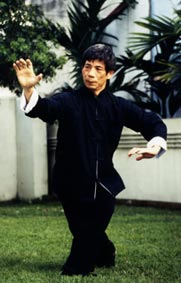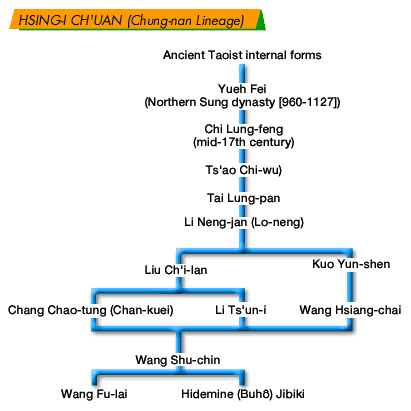Hsing-I Chuan (Xing-Yi)
 Hsing-i Chuan arose out of the ancient Chinese philosophy surrounding the concept of Yin-Yang and the theory of the Five Elements; together with Tai Chi and Ba Gua Zhang(Pa Kua), it completes the trinity of 'internal' martial arts.
Hsing-i Chuan arose out of the ancient Chinese philosophy surrounding the concept of Yin-Yang and the theory of the Five Elements; together with Tai Chi and Ba Gua Zhang(Pa Kua), it completes the trinity of 'internal' martial arts.
The Five Fists, based upon the Five Elements of Metal, Water, Wood, Fire, and Earth, constitute the fundamental practice; when practiced diligently and continuously, they build up the body internally so that it is able to defend it_self against any external attack.
Although it looks very simple at first sight, it is a very strong martial art, whose secret techniques are so powerful that it was often said of it that "A single stroke leads to certain death."
Hsing-I Chuan (Xing-Yi) is an internal form whose name means "the boxing form given shape by thought," which indicates a great unity of thought and action. Although the actual creator of the art is unknown, old records state that while a certain Chi Lung-feng of Shanghai was practicing austerities in the Chung-nan mountains in the south of Hsi-an (Xian), he met a Taoist 'immortal' who taught him the art. Chi passed on the teachings of what came to be known as the Chung-nan lineage to Ts'ao Chi-wu, the General Commandant of Shansi province in the K'ang-hsi era [1662-1722] of the Ch'ing dynasty.
Hsing-I Chuan (Xing-Yi) is based upon the theory of the Five Elements, and its rudiments include "five fists": 1) splitting (metal), 2) drilling (water), 3) crushing (wood), 4) pounding (fire), and 5) crossing (earth). In addition to these five basic forms, Hsing-I Chuan (Xing-Yi) also has "twelve styles" based upon the movements of certain animals (some of them are mythical, as the forms originally derive from the ancient Chinese concept of the Zodiacal 12 Animals): 1) dragon, 2) tiger, 3) monkey, 4) horse, 5) alligator, 6) cock, 7) falcon, 8) swallow, 9) snake, 10) t'ai (a mythical bird), 11) hawk, and 12) bear.
The movement of Hsing-I Chuan (Xing-Yi) is basically linear, and it uses mostly vertical strength and the closed fist. At first glance it appears similar to Karate and Shaolin forms, but, unlike in those forms, the body is completely relaxed--one might compare it to a coiled snake that is completely relaxed yet ready to strike like lightning in a flash.







